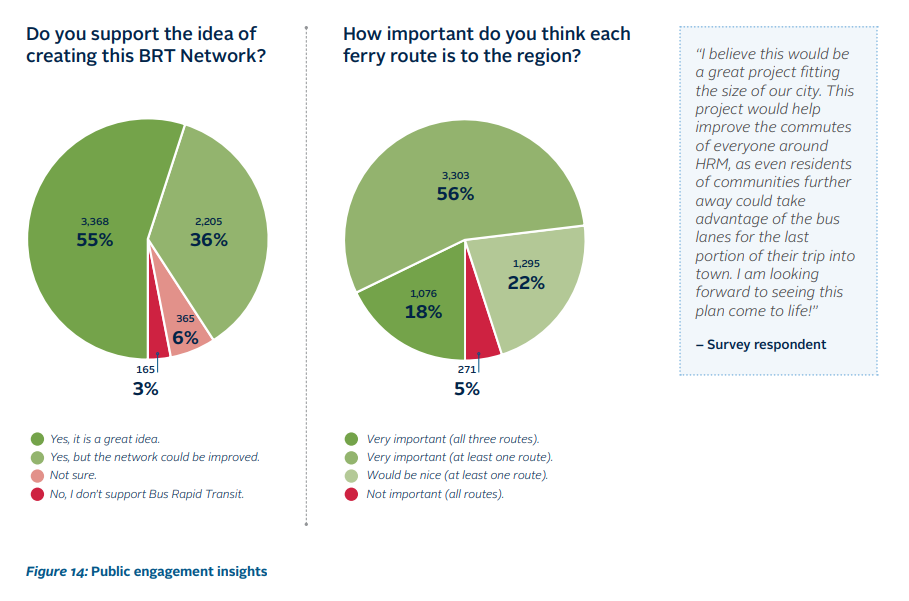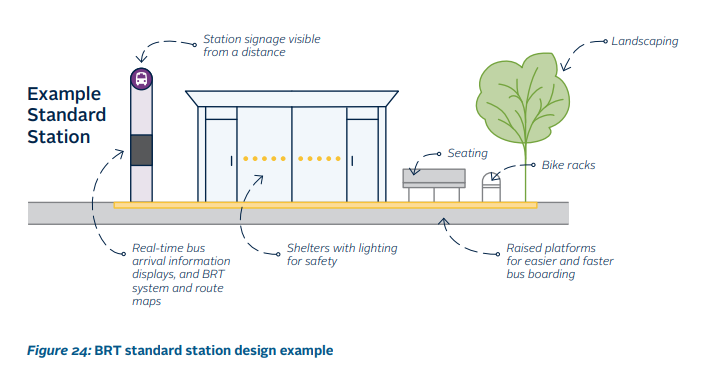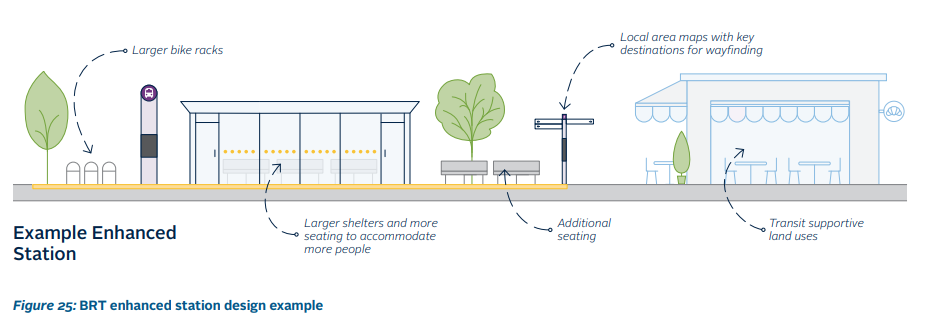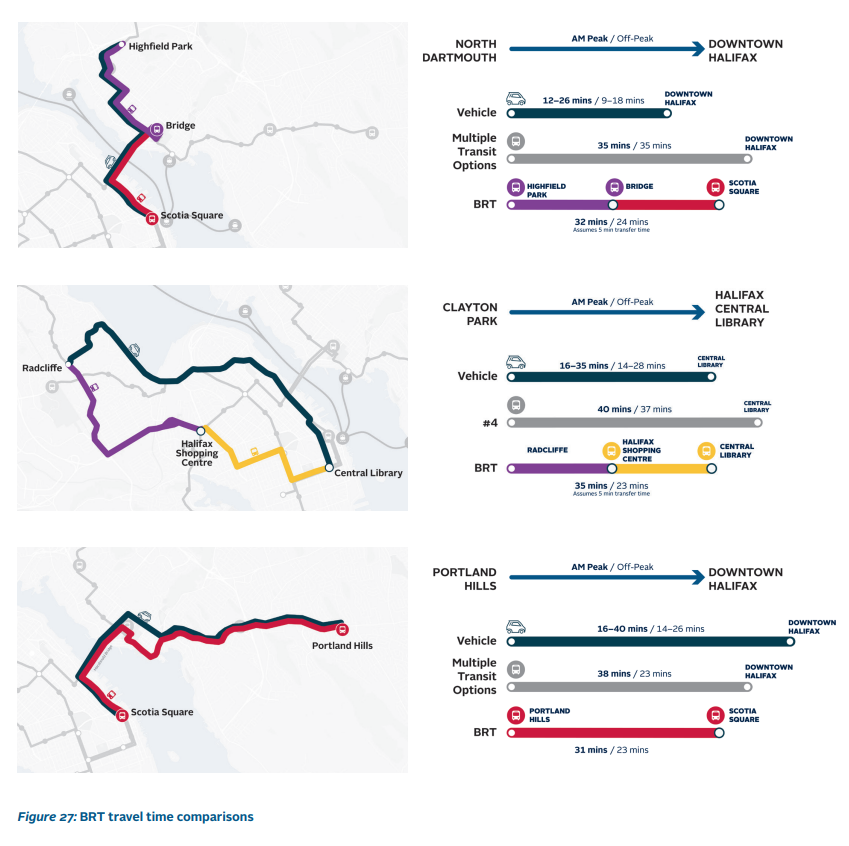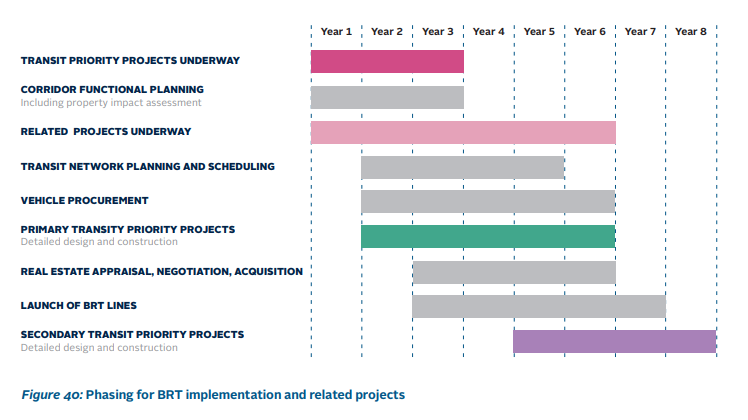Where is the progress on HRM's Rapid Transit Strategy?
In May 2020, HRM released a detailed report outlining the city's Rapid Transit Strategy for the next 10 years. With a proposed four new bus routes, three new ferry routes, dedicated bus lanes, improved stations and stops, and other additional improvements to the overall transit network.

The BRT lines will operate every ten minutes and will be within walking distance of approximately 120,000 residents, helping in the creation of complete communities by orienting land use towards transit and reducing the need to invest in road expansions. In turn, complete communities contribute to improved public health from higher rates of walking, rolling, and cycling in conjunction with transit use.
The three new proposed ferry routes will provide direct connections between downtown Halifax and new terminals at Mill Cove, Larry Uteck and Shannon Park. These routes would provide reliable service with travel times to downtown Halifax likely faster than travel by private vehicle or bus. The routes are anticipated to use multi-hull catamaran vessels with a 150-passenger capacity and a single deck, capable of operating at higher speeds while minimizing wake effects.
Major Support
With 91% of feedback in support of the BRT network, and 95% supporting the ferry network, it appeared to have more than enough support and would be a shoe-in for implementation if the funding could be secured.
New Infrastructure
In conjunction with the new service, the plan proposed a significant improvement to the transit infrastructure as a whole. Large, sheltered, accessible stops and stations with bike parking and nearby amenities. Additional dedicated transit priority corridors with dedicated lanes and priority signaling. Improvements to existing stations and further integration with the existing bus and bike network to make transfers more convenient.
The standard BRT station will be a significant improvement over the current standard bus stop. While the basic design will be similar across the BRT network, each station will integrate into and connect with its surrounding area.
BRT stations with high ridership and at transfer points will be larger and provide more amenities than standard stations. They are also intended to become multi-use destinations rather than just places to wait. For example, stations may include small shops or a small park or plaza, they may be integrated into surrounding buildings, or they may emphasize a nearby attraction through their design.
The BRT lines will also stop at Halifax Transit terminals, offering convenient transfers to many local routes. Current amenities at the terminals, such as indoor or sheltered areas and washrooms, will also serve BRT passengers. Terminals will be modified to include BRT-specific elements such as bus-level platform boarding, distinct visual signage, and real-time arrival information.
Reduced Travel Times
Anyone who regularly takes transit in Halifax will know how much longer it can instead of driving, which really makes it a non-option for many people. Making the bus at least competitive with driving will be enough encourage new ridership for those wishing to avoid the stress of driving in rush hour traffic. Which consequently removes traffic from the streets, making it less congested for everyone.
BRT improves freedom of movement around the municipality by being more reliable and more frequent, getting to destinations more quickly, and connecting to other routes more easily. More importantly, it does this all day, not just during peak hours. The BRT network will reduce travel times compared to current transit routes, so that traveling by BRT is more competitive with traveling by private vehicle.
Implementation
With a clear plan, community feedback, and a overall budget of about ~$350M; the city would need to find additional funding outside of the regular tax budget to get this project started.
The capital investment needed to build the Rapid Transit Network is higher than any previous single investment the Municipality has made in public transit, and will only be possible by partnering with other levels of government for funding.
The federal and provincial governments have both announced meaningful efforts to tackle the climate crisis and are targeting transportation as a key component of those efforts. Canada is working to reduce greenhouse gas emissions to 30% below 2005 levels by 2030 under the Pan-Canadian Framework for Clean Growth and Climate Change. Nova Scotia has recently established the Sustainable Development Goals Act, aiming to make the province net-zero by 2050. The Rapid Transit Strategy is key to achieving these federal and provincial priorities.
One potential source of funding for much of the Rapid Transit Strategy is the Public Transit Infrastructure Fund (PTIF), which the federal government has established to fund transformational transit infrastructure projects like Rapid Transit. The second phase of PTIF is well aligned to potentially fund a large portion of the implementation of the Rapid Transit Strategy.
Implementation of BRT will require vehicle procurement, station design and construction, transit scheduling and network adjustments, and infrastructure projects on BRT corridors. The Strategy anticipates BRT service to be fully operational in seven to eight years after funding is confirmed, with the first BRT line introduced in year three or four.
Where are we now?
It's been almost four years since the release of the Rapid Transit Strategy. Where are we currently in the implementation phase of this project? Well... nothing. The funding has not be secured so the project has been in limbo since it's announcement. If the funding was immediately picked up, then we would be almost halfway though the implementation, and we would have at least 1-2 of the BRT lines fully operational by now, additional transit priority lanes, and some improved bus stops.
Lack of Funding
On January 6th, 2023 the province released it's Five Year Highway Improvement Plan budgeting ~$1 billion towards expanding the existing highway infrastructure. In the almost four years since the publication of the Rapid Transit Strategy, the project has not secured any funding for it's implementation. With an initially proposed eight year duration for the completion of the project, we are nearly four years in, and have nothing to show for it.
The Five-Year Highway Improvement Plan released today, January 6, will see about $450 million invested in 2023-24 in roadwork and major projects already underway. The Province is also committing $583 million for six new major construction projects, to be constructed between 2025 and 2030.
The Halifax Examiner released an article on January 9th, 2023 reporting on the Five Year Highway Improvement Plan outlining their frustrations with provinces lack of ambition of getting the Rapid Transit Strategy funded.
I’ve never quite understood why taking the bus is seen as “déclassé, the domaine of losers and chumps.” I take the bus every day, and I find it freeing — I can read or listen to podcasts while travelling, I don’t have to worry about finding and paying for parking, and I can have a couple of drinks at the end of the day without putting anyone’s life in danger. My personal bus commute is almost ridiculously easy — I live near the Bridge Terminal, and there are so many buses going downtown that I don’t bother with looking at schedules — but I realize not everyone is so fortunate. That’s why I want to see the good service I receive extended to as many other people as possible.
In contrast, we can do a lot to increase bus ridership inexpensively and incrementally, one step at a time, improving service on this route, better organizing the path of this other route, increasing frequency, putting in bus lanes and bus-activated transit lights. And if putting a couple more buses on Route C doesn’t increase ridership, the buses can be moved over to Route H to see if they work there. It’s the tiny steps that make transit more nimble, and a collection of tiny steps can lead to very large success.
And the proposed BRT system is exactly that: a well thought-out, incremental approach to dramatically improving the existing bus system at a relatively low cost. The province should immediately match the federal funding for the BRT.
Lack of Prioritization
With the costs of the Highway 107 Extension ballooning, passing the expected deadline of Fall 2023 and being nowhere close to finished; we continue to let our municipal leaders make decisions that negatively affect the wellbeing of our citizens, the environment, and the future our kids will grow up in.
Car dependency was a mistake; which we are only really beginning to understand the full impact of in recent years. It is not too late to undo a lot of the damage that was done when we bulldozed and paved highways into the downtowns of our cities, ripped out tram and train tracks to make way for larger roads, clear cut forest and natural habitats to make way for urban sprawl. We can redevelop our cities into the dense, walkable, and enjoyable places that we used to live in for thousands of years before that advent of the personal automobile.

